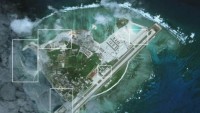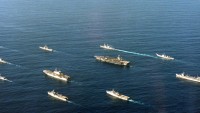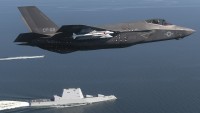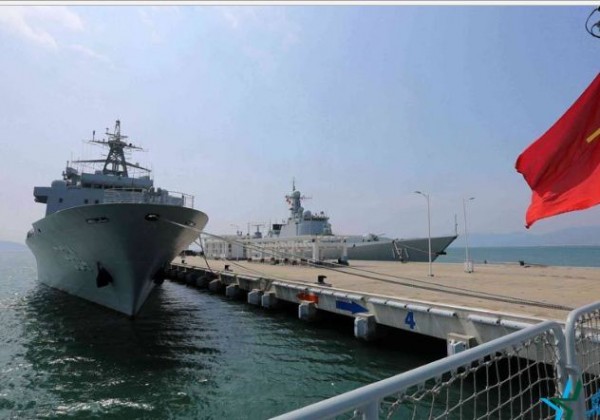China’s Navy Holding ‘Confrontation Drills’ at Disputed Paracel and Spratly Islands
| Arthur Dominic Villasanta | | Feb 13, 2017 09:33 AM EST |
(Photo : PLAN) The supply ship Luomahu (left) and the destroyer, CNS Haikou.
A three-ship squadron of the People's Liberation Army Navy (PLAN) left port Feb. 10 for what PLAN described as a series of "confrontation drills" at the militarized Paracel Islands and Spratly Islands in the disputed South China Sea.
The Type 052D guided missile destroyer CNS Changsha (173) and the Type 052C guided missile destroyer CNS Haikou (171) left their home port at Sanya on Hainan Island along with the Luomahu (964), a Type 903 replenishment ship, for the joint exercise with the PLAN Naval Air Force and units of the People's Liberation Army Ground Force occupying these islands.
Like Us on Facebook
Both destroyers belong to the South Sea Fleet responsible for the defense of the South China Sea.
PLAN said three helicopters are aboard both destroyers, as are dozens of men from the PLAN Marine Corps. The "confrontation drills" will include joint air defense operations; maritime defense operations; naval escort; anti-terrorism and anti-piracy operations in the South China Sea, the eastern Indian Ocean and the Western Pacific Ocean.
The PLAN Naval Air Force involved in the drills will come from the South Sea Fleet while other warships will come from the East Sea Fleet and the North Sea Fleet.
PLAN said this far-sea training is a routine arrangement in accordance with its annual plan. The drills are in line with international laws and conventions, said Rear Admiral Yu Manjiang, commanding officer of the task force and deputy commander of the South Sea Fleet.
PLAN has deployed four of the five operational Type 052D guided missile destroyers -- its most modern -- to the South Sea Fleet.
Chinese military analysts said the deployment of the Type 052D (NATO code name: Luyang III-class) to the South Sea Fleet indicates the strategic priority of PLAN has shifted to the southern end of the "First Island Chain," which they identified as a "weak spot" the U.S.-Japan military alliance has been "working hard" to exploit.
They also claim the Type 052D destroyers and the older and less capable Type 052C destroyer (of which only six were built) together form a "stepped difference in combat force."
TagsPeople's Liberation Army Navy, PLAN, confrontation drills, Paracel Islands, spratly islands, South China Sea, CNS Changsha, CNS Haiko, Luomahu, PLAN Naval Air Force
©2015 Chinatopix All rights reserved. Do not reproduce without permission
 China Strengthening Defenses of Military Outposts in Paracel Islands
China Strengthening Defenses of Military Outposts in Paracel Islands Dangerous Escalation: US Navy will Sail its Warships Closer to China’s Man-Made Islands in South China Sea
Dangerous Escalation: US Navy will Sail its Warships Closer to China’s Man-Made Islands in South China Sea US Navy to Develop New and Far Deadlier Air Superiority Stealth Fighter Replacing F-35
US Navy to Develop New and Far Deadlier Air Superiority Stealth Fighter Replacing F-35 People's Liberation Army Navy Aims for 500 Ship Fleet
People's Liberation Army Navy Aims for 500 Ship Fleet
EDITOR'S PICKS
-

Did the Trump administration just announce plans for a trade war with ‘hostile’ China and Russia?
-

US Senate passes Taiwan travel bill slammed by China
-

As Yan Sihong’s family grieves, here are other Chinese students who went missing abroad. Some have never been found
-

Beijing blasts Western critics who ‘smear China’ with the term sharp power
-

China Envoy Seeks to Defuse Tensions With U.S. as a Trade War Brews
-

Singapore's Deputy PM Provides Bitcoin Vote of Confidence Amid China's Blanket Bans
-

China warns investors over risks in overseas virtual currency trading
-

Chinese government most trustworthy: survey
-

Kashima Antlers On Course For Back-To-Back Titles
MOST POPULAR
LATEST NEWS
Zhou Yongkang: China's Former Security Chief Sentenced to Life in Prison

China's former Chief of the Ministry of Public Security, Zhou Yongkang, has been given a life sentence after he was found guilty of abusing his office, bribery and deliberately ... Full Article
TRENDING STORY

China Pork Prices Expected to Stabilize As The Supplies Recover

Elephone P9000 Smartphone is now on Sale on Amazon India

There's a Big Chance Cliffhangers Won't Still Be Resolved When Grey's Anatomy Season 13 Returns

Supreme Court Ruled on Samsung vs Apple Dispute for Patent Infringement

Microsoft Surface Pro 5 Rumors and Release Date: What is the Latest?










